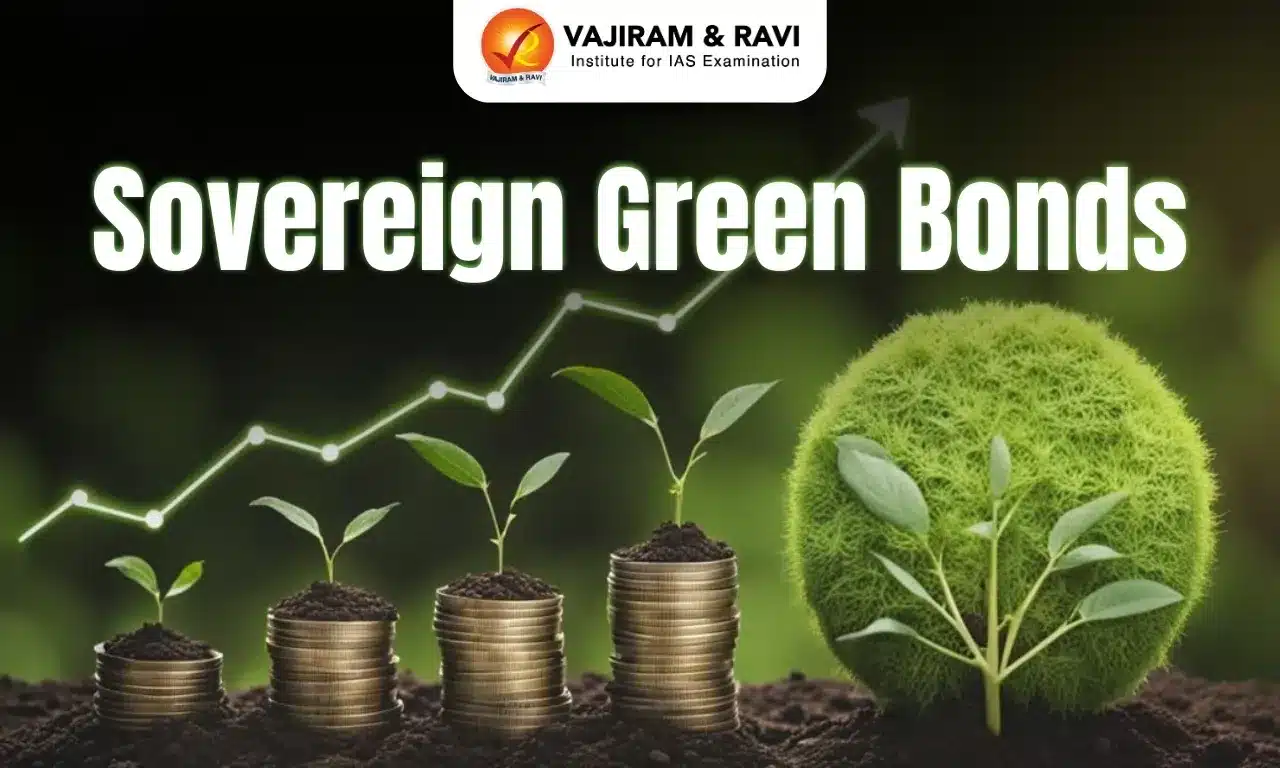Sovereign Green Bonds Latest News
Like several emerging markets, India also turned to sovereign green bonds to help fund its transition to a low-carbon economy, but investor demand remains weak.
About Sovereign Green Bonds
- SGBs are debt securities issued by a national government to fund projects that have positive environmental benefits.
- The proceeds from these bonds are exclusively allocated to green initiatives, which can include renewable energy projects, sustainable agriculture, waste management, and more.
- Essentially, these bonds are a way for governments to raise capital while promoting environmental sustainability.
Sovereign Green Bonds in India
- The Union Budget 2022-23 announced the issue of SGrBs.
- The framework for the SGrBs was issued by the government on November 9, 2022.
- What does the framework entail?
- The government’s framework is based on the International Capital Market Association’s (ICMA) listed principles for issuing green bonds, which has four components:
- Use of proceeds, project evaluation and selection, management of proceeds, and reporting.
- The government said the bonds’ proceeds will be used for green projects that:
- Encourage energy efficiency
- Reduce carbon emissions and greenhouse gases
- Promote climate resilience and/or adaptation
- Improve natural ecosystems and biodiversity, especially in accordance with the principles of sustainable development goals
- The framework listed investments in solar, wind, biomass, and hydro energy projects, and urban mass transportation projects such as metro rail, green buildings, pollution prevention and control projects.
- The government excluded projects such as fossil fuels, nuclear power generation, and direct waste incineration.
- The eligible expenditure is limited to government spending that occurred not more than 12 months prior to issuance.
- The proceeds should be allocated to projects within 24 months of issuing the bonds.
- If an eligible green project is postponed or cancelled, it will be replaced by another eligible green project.
- The government’s framework is based on the International Capital Market Association’s (ICMA) listed principles for issuing green bonds, which has four components:
How will Green Projects be Evaluated and Reported?
- The Ministry of Finance has constituted a Green Finance Working Committee composed of relevant ministries and chaired by the chief economic adviser.
- The ministries will submit their projects to the committee, which will meet at least twice a year to evaluate the proposals.
- Once the projects are evaluated, the final list will be given to the budget division of the finance ministry.
- The division will then issue the bonds through the RBI and use the proceeds to finance the selected projects.
- The government will release an annual report on the selection of green projects, the funds deployed, and their impact on the greening of the economy.
- It will also maintain a Green Register with details of the green bond issuance, the proceeds generated, allocations made, and information about the eligible projects.
Sovereign Green Bonds FAQs
Q1. What are green bonds issued by the RBI?
Ans. Green Bonds issued by the RBI are a type of sovereign bond aimed at raising funds for environmentally sustainable projects.
Q2. What is the maturity period of sovereign green bonds?
Ans. The maturity period of sovereign green bonds typically ranges from 5 to 10 years, depending on the specific terms of the bond issuance.
Q3. What is a bond?
Ans. A bond is a debt security issued by an entity (such as a government, corporation, or municipality) to raise funds.
Source: IE
Last updated on August, 2025
→ UPSC Mains Question Paper 2025 is out for Essay, GS 1 & GS 2.
→ UPSC Mains GS 3 Question Paper 2025 is now out.
→ UPSC Mains GS 4 Question Paper 2025 is now out.
→ UPSC Mains 2025 will be conducted on 22nd August 2025.
→ UPSC Notification 2025 was released on 22nd January 2025.
→ UPSC Calendar 2026 is released on 15th May, 2025.
→ UPSC Prelims Question Paper 2025 and Unofficial Prelims Answer Key 2025 are available now.
→ UPSC Prelims Result 2025 is out now for the CSE held on 25 May 2025.
→ The UPSC Vacancy 2025 were released 1129, out of which 979 were for UPSC CSE and remaining 150 are for UPSC IFoS.
→ UPSC Prelims 2026 will be conducted on 24th May, 2026 & UPSC Mains 2026 will be conducted on 21st August 2026.
→ The UPSC Selection Process is of 3 stages-Prelims, Mains and Interview.
→ UPSC Result 2024 is released with latest UPSC Marksheet 2024. Check Now!
→ UPSC Toppers List 2024 is released now. Shakti Dubey is UPSC AIR 1 2024 Topper.
→ Also check Best IAS Coaching in Delhi














